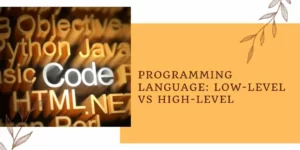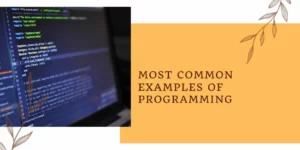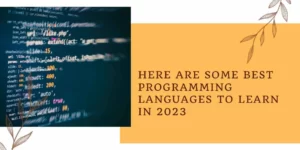Table of Contents
ToggleIntroduction
Which Programming Languages should you focus on in 2023 to stay ahead in the rapidly evolving tech landscape? Welcome! Today’s blog is dedicated to all things programming: we’re here to help you navigate through the best programming languages worthy of your attention in 2023.
Through this discussion, we’ll be examining longstanding favorites like Python and Java alongside newer options such as Rust or Ruby—exploring their respective strengths as well as likely areas for future growth or application opportunities
Whether you’re a seasoned programmer looking for additional career advancement or someone completely new to coding and wondering where to start—we have something in store for everyone! Join us today on our journey through the essential programming languages with game-changing potential.
Programming Language: Low-Level Vs High-Level

Low-Level Programming
Accessing direct computer hardware is possible through the choice of low-level programming languages enabling developers to take full control of powerful elements like memory storage areas, CPU processes, and input/output (I/O) interfaces.
System-level programs – such as OS programs and driver applications- are well suited for low-level programming techniques consistently producing effective results. Yet, making guarantees on improved readability or simple maintenance proves difficult with such robust systems as they require developers to work without abstract constraints that higher-level language environments provide.
Low-level programming typically refers to machine code or assembly language instructions that rely primarily on binary values representing either 0s or 1s coded into the memory available within specified hardware devices. It has become almost synonymous with the ability to interact significantly with a particular device, including its CPU subsystem and other peripheral interfaces.
The underlying machinery required to facilitate this interaction brought some other system features into play so that even mid-level programming codes (such as C/C++) showcase significant interactions with hardware components too – further validating their rejection of high-order coding abstractions provided by popular coding frameworks.
High-Level Programming
This is mostly what programmers mean when they discuss programming languages. These languages often feature human-friendly syntax, which makes them simpler to comprehend, develop, and maintain than low-level languages.
These offer a high level of abstraction and typically give less direct hardware control. However, one advantage is that they frequently have capabilities like type-checking, dynamic typing, and automated memory management.
Various forms of applications can be designed with ease by utilizing state-of-the-art high-level programming languages specifically geared towards desktops or mobiles or even for online platforms alongside AI-based systems. Prime selections encompass Python, JavaScript, Java, and Ruby.
Most Common Examples of Programming

Different approaches to developing and organizing code are known as programming paradigms. They offer guidance for fixing issues and have an impact on a programmer’s perspective on software creation. We’ll examine five prevalent programming paradigms.
Object Oriented Programming
Classes and objects are used in OOP to address issues. Classes offer a template for encoding an object’s data and behavior. Consequently, objects are examples of classes. Modeling real-world objects and ideas is best done with OOP. Python, C++, and Java are common examples of languages that enable OOP.
Imperative Programming
If you seek to mend a problem with your computer system it’s crucial to furnish it with a definite set of instructions for execution. Broadly speaking programming languages such as C, Java, and Python align with this methodology.
Functional programming
According to this paradigm, functions can be supplied as arguments, returned as results, or assigned as variables when creating a program. Functional language examples include Haskell, Lisp, and F#. But languages like Python and JavaScript may also use this model.
Procedural Programming
This method divides issues into simpler, more manageable pieces that are simple to comprehend and modify. Code is sometimes broken up into blocks known as procedures or subroutines, which are composed of more manageable, clearly defined tasks. The procedural technique is supported by the languages C, Pascal, and FORTRAN.
Logic Programming
In this paradigm, conclusions are reached by using logical principles. In other words, a program is a set of information and guidelines that a computer employs to solve a problem. Mercury and Prolog are two instances of logic programming languages.
Check out our Best Data Science Course
Here Are Some Best Programming Languages to Learn in 2023

Java
Java is a popular object-oriented programming (OOP) language, which was created in the ’90s by Sun Microsystems – currently owned by Oracle Inc – primarily known for introducing innovative technologies globally.
The unique selling point of this language lies in its “write once, run anywhere” facility which allows developers’ source codes portability across different devices being implemented using JVM regardless of fundamental operating systems- today used almost everywhere.
Another aspect lauded amongst programmers is how easy it makes implementing reusable code modules with OOP designing solutions resulting in wide integration within big corporations’ enterprise management systems around the world favoring stable platforms with enhanced security measures.
Additionally, many educational institutions attribute Java as an effective tool for practical computer science teachings that seamlessly introduce students to OOP.
JavaScript
JavaScript – a widely popular scripting language that enables dynamic web page creation designed for utilization together with HTML and CSS; allowing for sophisticated novel displays by empowering customer engagement through click-and-dragging or other similar interactive features supporting over 98% of websites are prime examples where this technology is prevalent.
For individuals who possess an interest in web development or design-related work; comprehending Javascript will be paramount as it provides versatility well beyond improvements in front-end operations.
Learning back-end programming using Node.js or scripting games alike are other competencies worth engaging via JavaScript training courses which adequately eliminate the dread that comes from handling mundane administrative jobs including repetitive task automation alike.
Additionally, JavaScript being amongst the top competing languages offers numerous documentation tutorials pre-designed classes active forums, and various other resourceful mater
ials accessible online and tailor-made for one’s training expectedly, aiding one’s skill-based enhancement requirement whilst providing comprehensive technical support from the community.
Python
Regarded by many as an excellent multi-functional programming tool, Python offers users versatility and flexibility when coding applications for areas across web development, data science or AI uses. Its expanding popularity among peers also indicates it could likely be one of the top coding languages to master in upcoming years like 2023.
Beginners often turn to Python when looking for a coding language that’s simple yet powerful at the same time. Its straightforward syntax paired with an extensive range of available libraries and modules make it a go-to choice for budding programmers. With no steep learning curve attached, newcomers can confidently dive right into learning how to code with Python.
Assistance in advancing your prowess in using Python programming language comes in multiple forms through vast supportive networks across the web. Easy access to constructive tutorials and experts who can answer questions or provide guidance aids in completing complex projects without delays.
With its demand rising continuously since its inception, being proficient in Python opens numerous career possibilities such as data science, and software engineering development of cutting-edge technologies like artificial intelligence to name but a few others. You can browse through remote Python jobs available on our listing page to find your dream role.
SQL
When it comes down to managing relational databases solely through Structured Query Language (SQL). What this means is that developers can control exactly how their databases are structured whilst performing CRUD operations such as generating or modifying records still within one language program without switching languages code when necessary which can streamline several workflows saving resources on both time and cost compared to traditional methods.
These powerful features attribute to SQL being an incredibly popular choice for organizations across various industries whilst being integrated within industry-standard titles such as MySQL Oracle Microsoft’s very own SQL server amongst others. Individuals choice whether or not to learn SQL outright are tasked with discovering the requirements for their individual goals as a professional.
Regardless of the path an individual pursues, SQL is a universal skill that will offer many advantages for those seeking a career in technology fields.
C++
C++ stands out among other computer languages as a versatile tool for executing complex coding tasks effectively. Its origins date back to the early 1980s when its builders optimized the earlier version -C program- by including robust support for object-oriented principles leading to its current widespread use across numerous sectors globally as well as being statically typed making it an ideal choice for developing programs ranging from device drivers up to complicated systems with complex algorithms (Dijkstra).
Major software programs, operating systems, and device drivers are frequently developed using it. It’s also well-liked for scientific computing, financial applications, gaming creation, and building web browsers.
C++ possesses the useful feature of being compatible across multiple platforms. This attribute permits its use on diverse operating systems rendering it a desirable and flexible option, including macOS, Windows, and Linux. C++ is more potent and adaptable because it also provides low-level control over system resources to program developers. But because of its more complicated syntax, C++ is more challenging to master.
Rust
For systems programming, Mozilla created Rust. Rust gives low-level control with a focus on memory and thread safety and is frequently compared to C and C++. Developers have voted it the most favored language for seven years in a row, indicating how swiftly it has gained popularity.
Operating systems, device drivers, network protocols, as well as web applications, and command-line tools, are all frequent examples of systems software that uses Rust. Rust is an overall robust and contemporary programming language that is rapidly building a solid reputation.
Check out our Data Science Course in Delhi
Ruby
Ruby was created to be an expressive, succinct OOP language with a focus on increasing developer efficiency and code readability. It’s a fantastic language for beginners since it has dynamic typing and easy syntax.
Ruby is frequently used for automation, scripting, and creating command-line tools and utilities. The Ruby on Rails framework is available to Ruby users for web development. As a result, sophisticated applications may be quickly built and deployed using a convention-over-configuration approach to web development.
PHP
A server-side scripting language for web development that is open-source is PHP. More than 75% of websites today run on servers that utilize PHP, and well-known content management systems like WordPress were developed in PHP.
PHP programmers have access to databases via which they may store and retrieve data, process forms, send emails, and more. They can also construct sessions and cookies to monitor user activity.
There is a sizable open-source community that has developed tools, frameworks, extensions, and other resources to make PHP even more functional and user-friendly.
Conclusion
The demand for qualified programmers is only going to increase in the coming days, and your career chances and progress can be greatly impacted by your choice of programming language.
You may decide which languages to focus on in your learning process by exploring the top programming languages covered in this blog. Each language has its own benefits and uses cases, whether it be the adaptability and industry need of Python, the scalability and performance of Java, or the web development skills of JavaScript.
Keep in mind that learning programming languages require more than simply syntactic mastery; it also requires comprehension of the guiding ideas and tenets. It’s crucial to select a language that fits your hobbies, professional objectives, and the particular fields or sectors you want to work in.
So take on the challenge, start your learning process, and remain ahead by studying the top programming languages that will influence technology in 2023 and beyond.
Check out our Data Science Program in Pune
Frequently Asked Questions
What is a programming language?
The rules and syntax of a programming language are used to create computer programs. By giving people a formal means to convey instructions, it facilitates communication between people and machines.
Why are programming languages important?
This is because they enable programmers to construct the software and apps that run our digital world, programming languages are crucial. They give us a method to program computers and automate processes, enabling the creation of numerous everyday technologies
How many different programming languages exist?
There are many different types of programming languages, from widely used ones like Python, Java, and C++ to more specialized ones for particular applications like R for data analysis and MATLAB for scientific computing.
Which programming language should I learn first?
Depending on your objectives and interests, learning a programming language is a good initial step. Python is frequently suggested for novices because to its ease of use and flexibility. It is extensively utilized in many different fields, like as web development, data analysis, and automation, and it has a sizable community.
Can I switch between programming languages?
Yes, engineers frequently change between programming languages during the course of their careers. The shift to a new language is made simpler once you have a firm grasp of programming fundamentals since many fundamental ideas are portable. Although each language has its own syntax and ecology, the essential principle is the same.













